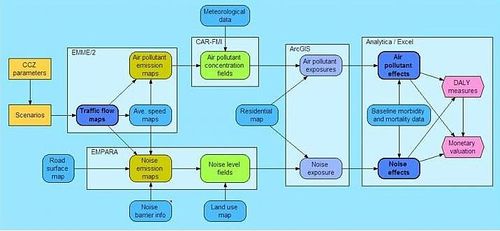IEHIAS models:example of transport
- The text on this page is taken from an equivalent page of the IEHIAS-project.
As part of the case studies done in support of development of this Toolbox, an assessment was undertaken of health effects of traffic management policies in several different cities in the EU.

The causal model used in the Helsinki case study is shown in the image.
The policy evaluated was the congestion charge zone (CCZ). The causal model was developed based upon the generic transport assessment protocol dapplied in all the study areas, but this was necessarily adapted to represent the specific policy assessed. The generic protocol started out with listing all the exposures and health effects associated with motorised road traffic. Problems related to transport identified were air pollution, climate change, water and soil pollution, transport accidents and injuries, traffic noise, physical inactivity, psychological and social effects, but also problems such as the use of fossil fuels, and the loss of public space/land/natural habitats etc.
In many settings, traffic congestion and resulting (economic) losses is considered as a major problem. Congestion is therefore an important rationale for policies to reduce traffic flows. Accordingly, we then assessed which of these stressors were likely to be most important and could be quantified. The policy in Helsinki was anticipated to change the traffic intensity, traffic speed and the distribution of trips over different modes of transport (away from private car use to public transport and active transportation including cycling and walking). On this basis, attention was focused especially on four likely areas of impact: air pollution, noise, traffic accidents and physical activity. These formed the overall framework for the assessment. For practical reasons (of time and resources), however, the case study ultimately focused further on just two issues: air pollution and noise.
The causal model was built in consultation with the other members of the assessment team, Dutch stakeholders (especially the Ministry of Transport and local authorities) and stakeholders from the municipality of Helsinki.